Microsoft 1804 802.11n 1T2R wireless radio User Manual Y720 15 IKB UG EN
Microsoft Corporation 802.11n 1T2R wireless radio Y720 15 IKB UG EN
Contents
Users Manual-1

Y720-15IKB
Read the safety notices and important tips in the
included manuals before using your computer.
Lenovo Y720
User Guide
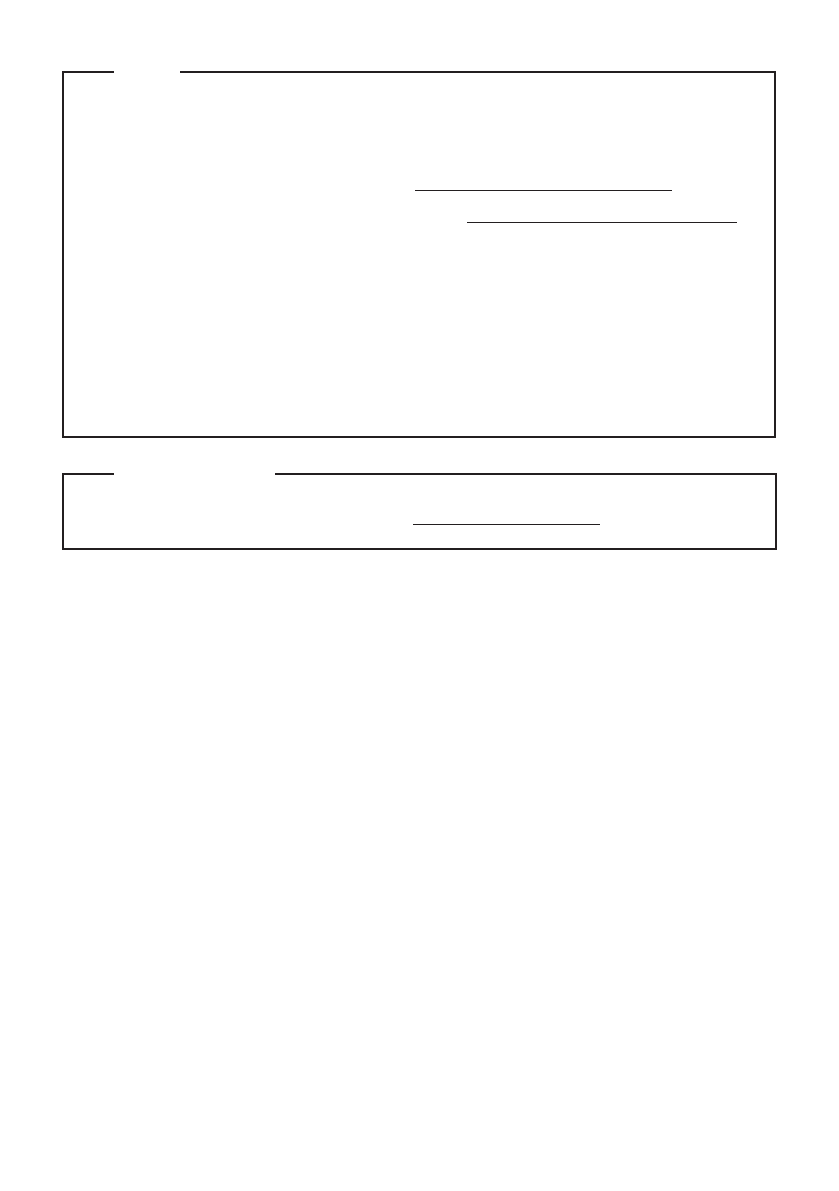
First Edition (December 2016)
© Copyright Lenovo 2016.
LIMITED AND RESTRICTED RIGHTS NOTICE: If data or software is delivered pursuant to a General
Services Administration “GSA” contract, use, reproduction, or disclosure is subject to restrictions set
forth in Contract No. GS-35F-05925.
For details, refer to Guides & Manuals at hp://support.lenovo.com.
Regulatory Notice
Before using the product, be sure to read Lenovo Safety and General Information Guide first.
The features described in this guide are common to most models. Some features may not
be available on your computer or your computer may include features that are not
described in this user guide.
Some instructions in this guide may assume that you are using Windows® 10. If you are
using another Windows operating system, some operations may be slightly different. If
you are using other operating systems, some operations may not apply to you.
Notes
•
•
•
•
The illustrations in this manual may differ from the actual product. Please refer to the
actual product.
•
- To view compliance information go to: hp://www.lenovo.com/compliance
-
To download environmental information go to: hp://www.lenovo.com/ecodeclaration
The latest electronic compliance and environmental information are available from the
Lenovo compliance information Web sites.
•
i
Contents
Chapter 1. Getting to know your computer .................................................................................... 1
Top view ......................................................................................................................................................... 1
Left-side view ................................................................................................................................................ 5
Right-side view .............................................................................................................................................. 8
Bottom view ................................................................................................................................................... 9
Chapter 2. Starting to use Windows 10......................................................................................... 10
Configuring the operating system for the first time .............................................................................. 10
Operating system interface ........................................................................................................................ 10
Putting the computer to sleep or shutting it down ................................................................................ 12
Task and desktop management ................................................................................................................ 14
Connecting to a wireless network ............................................................................................................ 15
Get Started app ............................................................................................................................................ 15
Chapter 3. Recovery system .......................................................................................................... 16
Lenovo OneKey Recovery System ............................................................................................................ 16
Reset this PC ................................................................................................................................................ 17
Chapter 4. Troubleshooting............................................................................................................ 18
Frequently asked questions ....................................................................................................................... 18
Troubleshooting .......................................................................................................................................... 21
Trademarks...................................................................................................................................... 25
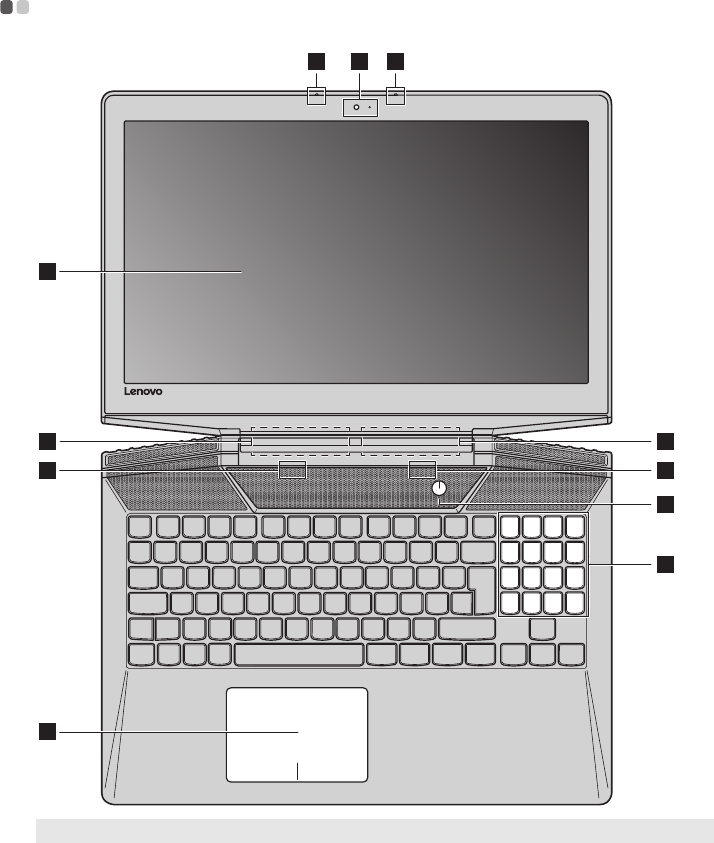
1
Chapter 1. Getting to know your computer
Top view - - - - - - - - - - - - - - - - - - - - - - - - - - - - - - - - - - - - - - - - - - - - - - - - - - - - - - - - - - - - - - - - - - - - - - - - - - - - - - - - - - - - - - - - - -
Attention:
•Do not open the display panel beyond 135 degrees. When closing the display panel, be careful not to leave
pens or any other objects in between the display panel and the keyboard. Otherwise, the display panel
may be damaged.
Note: The dashed areas indicate parts that are not visible externally.
3
8
5
12 2
4
7
5
6
4

2
Chapter 1. Getting to know your computer
aIntegrated camera Use the camera for video communication or taking photos.
bBuilt-in microphone Captures sound which can be used for video conferencing, voice
narration, or audio recording.
cComputer display Provides brilliant visual output.
dWireless LAN antennas Connect to a wireless LAN adapter to send and receive wireless radio
signals.
eSpeakers Provide audio output.
fPower button Press this button to turn on the computer.
gNumeric keypad For details, see “Using the keyboard” on page 3.
hTouchpad The touchpad functions as a conventional mouse.
Touchpad: To move the pointer on the screen, slide your fingertip over
the pad in the direction in which you want the pointer to move.
Touchp ad buttons : The functions of the left/right side correspond to that
of the left/right mouse button on a conventional mouse.
Note: You can enable/disable the touchpad by pressing Fn + F6.
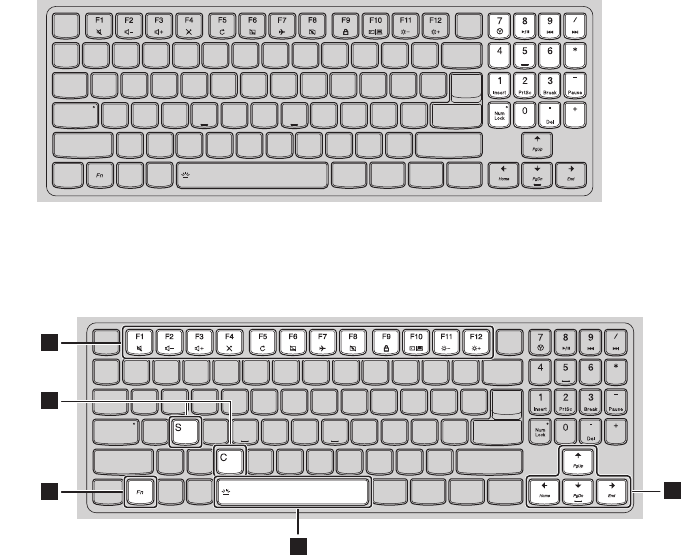
Chapter 1. Getting to know your computer
3
Using the keyboard
Numeric keypad
The keyboard has a separate numeric keypad. To enable or disable the numeric keypad, press
the Num Lock key.
Function key combinations
Through the use of the function keys, you can change operational features instantly. To use this
function, press and hold Fn ; then press one of the function keys .
a
b
2
2
2
1
2
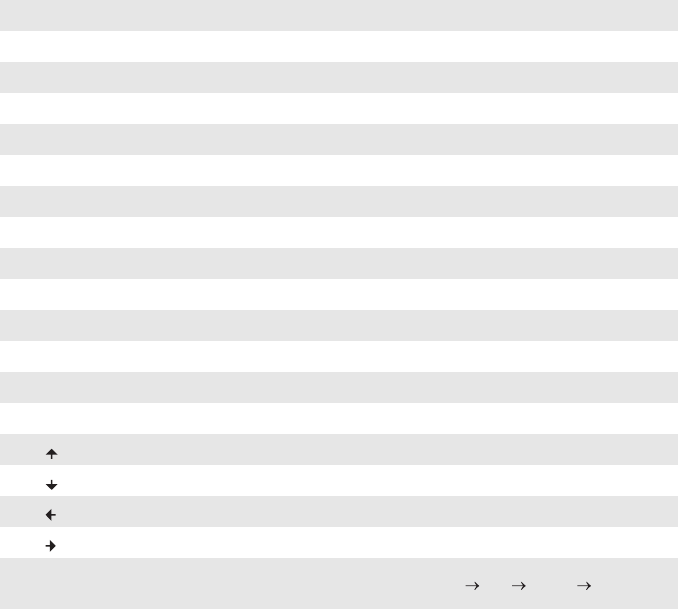
4
Chapter 1. Getting to know your computer
The following describes the features of each function key.
Fn + F1: Mutes/unmutes the sound.
Fn + F2: Decreases the volume level.
Fn + F3:Increases the volume level.
Fn + F4: Enables/disables the microphone.
Fn + F5: Refreshes the desktop or the currently active window.
Fn + F6: Enables/disables the touchpad.
Fn + F7: Enables/disables Airplane mode.
Fn + F8: Enables/disables the integrated camera.
Fn + F9: Locks the screen.
Fn + F10:
Toggles the display between the computer and an external device.
Fn + F11: Decreases the display brightness.
Fn + F12: Increases the display brightness.
Fn + C: Enables/disables the scroll lock.
Fn + S: Activates the system request.
Fn + : Activates the Pgup key function.
Fn + : Activates the Pgdn key function.
Fn + : Activates the home key function.
Fn + : Activates the end key function.
Fn + Space
(on select models): Adjusts the keyboard backlight (off dim bright off).
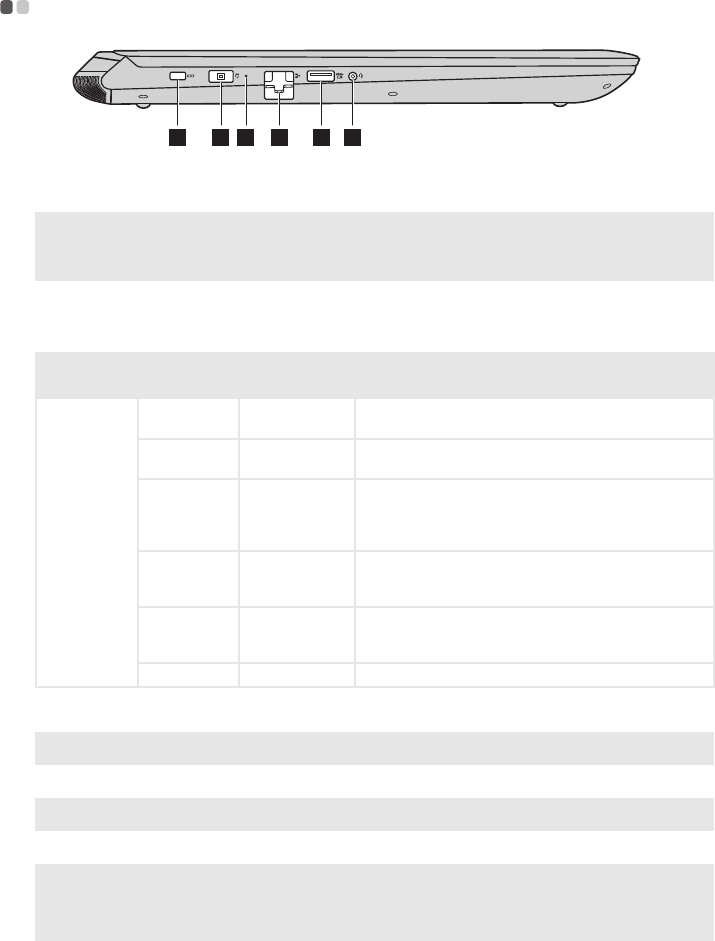
Chapter 1. Getting to know your computer
5
Left-side view - - - - - - - - - - - - - - - - - - - - - - - - - - - - - - - - - - - - - - - - - - - - - - - - - - - - - - - - - - - - - - - - - - - - - - - - - - - - - - - -
a
Kensington mini security
slot
For attaching a Kensington MiniSaver™ Mobile (or compatible) lock.
Note: Lock is not supplied. When purchasing a lock, choose one that utilizes the Cleat™ locking
mechanism and verify its compatibility with the slot before purchase. A lock utilizing the T-Bar™
locking mechanism is not compatible with the Kensington mini security slot.
bAC power adapter jack Connects to the AC power adapter.
cBattery status indicator
Indicator Indicator
status
Charge
status Meaning
Battery
On
(solid white) Charging The battery has more than 80% charge.
On
(solid amber) Discharging The battery has between 5% and 20% charge.
Blinking
slowly
(white)
Charging
The battery has between 20% and 80% charge. When
the battery reaches 80% charge, the light will stop
blinking. However, charging will continue until the
battery is fully charged.
Blinking
slowly
(amber)
Charging
The battery has between 5% and 20% charge. When the
battery charge reaches 20%, the blinking color will
change to white.
Blinking
quickly
(amber)
Charging/
Discharging The battery has less than 5% charge.
Off Discharging The battery has more than 20% charge.
dRJ-45 port Connects the computer to an Ethernet network.
Note: For details, see “Connecting network cables” on page 6.
eUSB port Connects to USB devices.
Note: For details, see “Connecting USB device” on page 7.
fCombo audio jack Connects to headsets.
Notes:
•The combo audio jack does not support conventional microphones.
•The recording function might not be supported if third-party headphones or headsets are connected,
due to different industry standards.
1 2 43 5 6
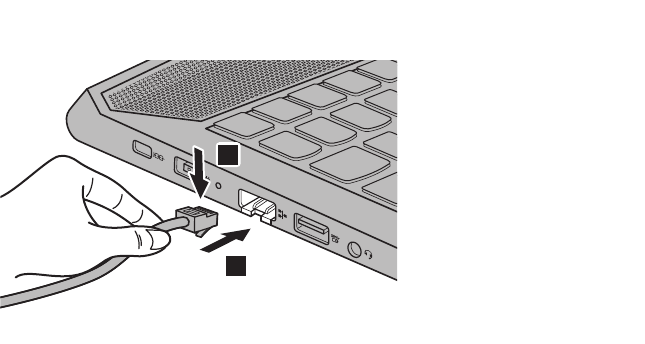
6
Chapter 1. Getting to know your computer
Connecting network cables
To insert a network cable, do the following:
1Hold one connector of the network cable to press the RJ-45 cover down gently .
2Insert the connector into the RJ-45 port .
Software configuration
Consult your Internet Service Provider (ISP) for details on how to configure your computer.
a
b
1
2
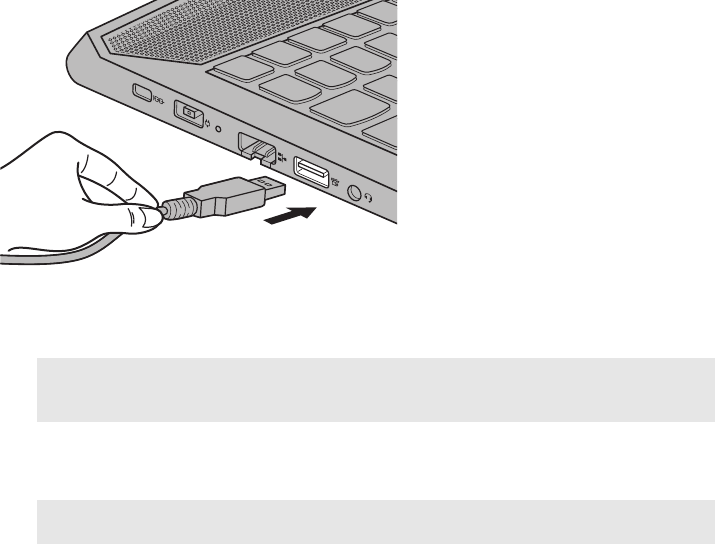
Chapter 1. Getting to know your computer
7
Connecting USB device
Your computer comes with three USB ports compatible with USB devices.
The first time you plug a USB device into a particular USB port on your computer, Windows
automatically installs a driver for that device. After the driver has been installed, you can
disconnect and reconnect the device without performing any additional steps.
Before disconnecting a USB storage device, make sure your computer has finished transferring
data to that device. Click the Safely Remove Hardware and Eject Media icon in the Windows
notification area to remove the device before disconnecting.
Note: Typically, Windows detects a new device after it has been connected, and then installs the driver
automatically. However, some devices may require you to install the driver before connecting. Check
the documentation provided by the device’s manufacturer before connecting the device.
Note: If your USB device uses a power cord, connect the device to a power source before connecting it.
Otherwise, the device may not be recognized.
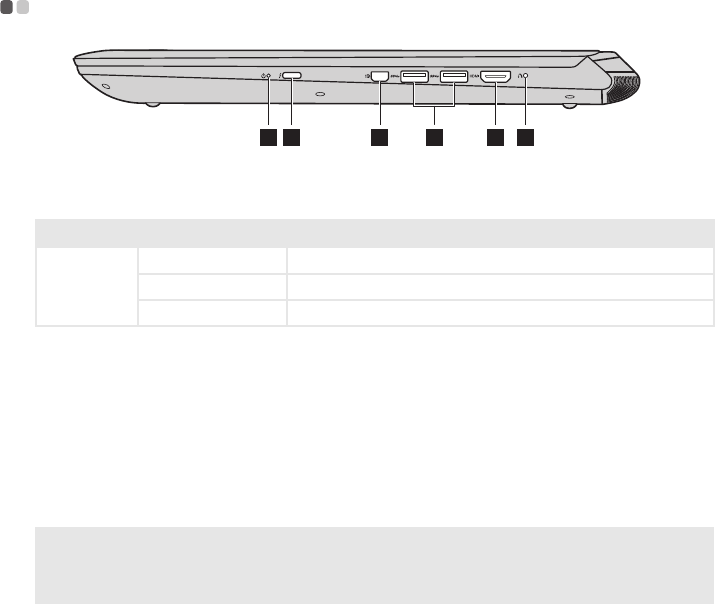
8
Chapter 1. Getting to know your computer
Right-side view - - - - - - - - - - - - - - - - - - - - - - - - - - - - - - - - - - - - - - - - - - - - - - - - - - - - - - - - - - - - - - - - - - - - - - - - - - - - -
aPower status indicator
Indicator Indicator status Meaning
Power
On (solid white) The computer is powered on.
Blinking The computer is in sleep mode.
Off The computer is powered off.
bTyp e- C po rt Connects to Type-C devices.
cDisplayPort connector Connects to an external display device.
dUSB ports Connect to USB devices.
eHDMI port Connects to devices with HDMI input such as a TV or an external
display.
fNovo button When the computer is off, press this button to start the recovery system
(Reset this PC) or the BIOS setup utility, or to enter the boot menu.
Notes:
•You can use the tip of an unfolded paper clip (or similar object without a sharp tip) to gently press the
Novo button.
•For details, see “Recovery system” on page 16.
21 3 5 6
4

Chapter 1. Getting to know your computer
9
Bottom view - - - - - - - - - - - - - - - - - - - - - - - - - - - - - - - - - - - - - - - - - - - - - - - - - - - - - - - - - - - - - - - - - - - - - - - - - - - - - - - - - - -
Note: The dashed areas indicate parts that are not visible externally.
aVentilation slots Dissipate internal heat.
Note: Make sure that the ventilation slots are not blocked or else the computer may overheat.
bLouvers Allow air to enter the computer for cooling.
cSpeaker Provides subwoofer audio output.
dX-Box antennas
(on select models)
2
34 4
1 1

10
Chapter 2. Starting to use Windows 10
Configuring the operating system for the first time - - - - - - - - - - - -
You may need to configure the operating system when it is first used.
The configuration process may include the procedures below:
• Accepting the end user license agreement
• Configuring the Internet connection
• Registering the operating system
• Creating a user account
Operating system interface - - - - - - - - - - - - - - - - - - - - - - - - - - - - - - - - - - - - - - - - - - - - - - - - - - - - - - - -
Windows 10 comes with a powerful and useful start menu.
To open the start menu, do one of the following:
• Press the Windows key on the keyboard.
• Select Start on the lower-left corner of the desktop.
Note: Windows® 10 has an updated version. If you are using the updated version, some operations may be
different. Please refer to the actual product.
aGet Started app dStart button
bSettings button eSearch box
cPower button fTask view button
1
2
3
4 5 6

Chapter 2. Starting to use Windows 10
11
Settings
Settings lets you perform basic tasks. You can also search for more settings with the settings
search box in the upper-right corner.
To open the settings, do the following:
• Open the start menu, and then select Settings .
Personalize the start menu
You can personalize the start menu with your favorite apps.
To personalize the start menu, do the following:
1Open the start menu and find the apps list on the left.
2Right click the app you want to add to the start menu, and then select Pin to Start.
Note: You can also drag apps from the apps list to add them to the start menu.

12
Chapter 2. Starting to use Windows 10
Putting the computer to sleep or shutting it down - - - - - - - - - - - - - -
When you have finished working with your computer, you can put it to sleep or shut it down.
Putting your computer to sleep
If you will be away from your computer for only a short time, put the computer to sleep.
When the computer is in sleep mode, you can quickly wake it to resume use, bypassing the
startup process.
To put the computer to sleep, do one of the following:
• Close the display lid.
• Press the Power button.
• Open the start menu, and then select Power Sleep.
To wake the computer, do one of the following:
• Press any key on the keyboard.
• Press the Power button.
Note: Wait until the power indicator light starts blinking (indicating that the computer is in sleep mode)
before you move your computer. Moving your computer while the hard disk is spinning can damage
the hard disk, causing loss of data.

Chapter 2. Starting to use Windows 10
13
Shutting down the computer
If you are not going to use your computer for a long time, shut it down.
To shut down the computer, do one of the following:
• Open the start menu, and then select Power Shut down.
• Right-click the Start button in the lower-left corner and select Shut down or sign out
Shut down.

14
Chapter 2. Starting to use Windows 10
Task and desktop management - - - - - - - - - - - - - - - - - - - - - - - - - - - - - - - - - - - - - - - - - - - - - - - -
Ta s k v i e w
To open the task view, do one of the following:
• Select the Task view button on the task bar.
• Press the Windows key + Tab.
Virtual desktop management
Windows 10 supports the ability to create, manage and switch between virtual desktops.
To create a new virtual desktop, do one of the following:
• Open the task view, and then select New desktop.
• Press the Windows key + Ctrl + D.
To switch between different desktops, do one of the following:
• Open the task view and select the desktop you want active.
• Press the Windows key + Ctrl + / to scroll through the desktops you’ve created.

Chapter 2. Starting to use Windows 10
15
Connecting to a wireless network - - - - - - - - - - - - - - - - - - - - - - - - - - - - - - - - - - - - - - - - - - - -
Enabling wireless connection
To enable wireless functions, do the following:
1Press Fn + F7 to disable airplane mode.
2Click on the lower-right corner of the task bar to open the network configuration page.
Connecting to a wireless network
After wireless has been enabled, the computer will automatically scan for available wireless
networks and display them in the wireless network list. To connect to a wireless network, click
the network name in the list, and then click Connect.
Get Started app - - - - - - - - - - - - - - - - - - - - - - - - - - - - - - - - - - - - - - - - - - - - - - - - - - - - - - - - - - - - - - - - - - - - - - - - - - - - -
Windows 10 also provides the Get Started app to explain the new features of Windows 10. You
can find it on the start menu.
To open the Get Started app, do one of the following:
• Open the start menu and select Get Started .
•Press F1 (depending on your keyboard layout).
Note: Some networks require a network security key or passphrase for connection. To connect to one of
those networks, ask the network administrator or the Internet service provider (ISP) for the security
key or passphrase.

16
Chapter 3. Recovery system
Lenovo provides Lenovo OneKey Recovery system or Reset this PC for system recovery, which
depends on the pre-installed software. Refer to the actual product. You can perform either to
start the system recovery.
Lenovo OneKey Recovery System - - - - - - - - - - - - - - - - - - - - - - - - - - - - - - - - - - - - - - - - - - - -
The Lenovo OneKey Recovery System is software designed to back up and restore your
computer. You can use it to restore the system partition to its original status in case of a system
failure. You can also create user backups for easy restoration as required.
Backing up the system partition
You can back up the system partition to an image file. This image file can be used to restore the
system partition. To back up the system partition:
1In Windows, double-click OneKey Recovery icon to start the Lenovo OneKey Recovery
System.
2Click System Backup.
3Select a back-up location and click Next to start the backup.
Restoring
You can choose to restore the system partition to its original status or to a previously created
back-up point. To restore the system partition:
1In Windows, double-click OneKey Recovery icon to start the Lenovo OneKey Recovery
System.
2Click System Recovery. The computer will restart to the recovery environment.
3Follow the on-screen instructions to restore the system partition to its original status or to a
previously created back-up point.
Notes:
•If your computer is preinstalled with a GNU/Linux operating system, OneKey Recovery System is not
available.
•To utilize the features of the OneKey Recovery System, your hard disk already includes a hidden
partition by default to store the system image file and the OneKey Recovery System program files. This
default partition is hidden for security reasons, which explains why the available disk space is less than
the stated capacity.
Notes:
•You can choose a back-up location on the local hard disk drive or an external storage device.
•Remove the removable hard disk drive before starting the Lenovo OneKey Recovery System. Otherwise,
data from the removable hard disk drive might be lost.
•The back-up process may take a while.
•The back-up process is only available when Windows can be started normally.
Notes:
•The recovery process is irreversible. Make sure to back up any data you wish to save on the system
partition before starting the recovery process.
•The recovery process may take a while. So be sure to connect the AC power adapter to your computer
during the recovery process.
•The above instructions should be followed when Windows can be started normally.

Chapter 3. Recovery system
17
If Windows cannot be started, then follow the steps below to start the Lenovo OneKey
Recovery System:
1Shut down the computer.
2Press the Novo button. From Novo Button Menu, select System Recovery and press Enter.
Reset this PC - - - - - - - - - - - - - - - - - - - - - - - - - - - - - - - - - - - - - - - - - - - - - - - - - - - - - - - - - - - - - - - - - - - - - - - - - - - - - - - - -
Introduction
Reset this PC is a built-in recovery tool that enables users to restore their operating system to its
original state. This preserves their data and important customizations, without the need to back
up their data in advance.
The following Reset this PC features are available to users from multiple locations within
Windows:
Keep my files
Fixes software problems by reinstalling the factory default configuration. This preserves
personal files, and deletes apps and settings.
Remove everything
Prepares the computer for recycling or transfer of ownership. This reinstalls the factory default
configuration and returns all user data and applications to the state of their original Out-of-Box
Experience (OOBE).
Using Reset this PC
Reset this PC can be launched using one of the following methods:
• Novo Menu:
- Press the Novo button to open the Novo Menu, then select System Recovery
Troubleshoot Reset this PC.
• Windows PC settings:
- Windows PC settings Update & security Recovery Reset this PC select Start.
For more instructions, see the Windows Help and Support file on your computer.
Notes:
•The Lenovo OneKey Recovery System may not be available on some Lenovo computers with
preinstalled Windows. To check your computer, go to Control Panel Programs and check whether
Lenovo OneKey Recovery is included in the installed programs list.
•If your computer is not preinstalled with Lenovo OneKey Recovery System, see “Reset this PC” on page 17.
Note: If your computer is preinstalled with Lenovo OneKey Recovery System, see “Lenovo OneKey
Recovery System” on page 16.

18
Chapter 4. Troubleshooting
Frequently asked questions - - - - - - - - - - - - - - - - - - - - - - - - - - - - - - - - - - - - - - - - - - - - - - - - - - - - - - -
This section lists frequently asked questions by category.
Finding information
Lenovo preinstalled operating system and software
What safety precautions should I follow when using my computer?
Read and follow all safety precautions included in Lenovo Safety and General Information Guide.
Note: To view Lenovo Safety and General Information Guide, select the Companion (or Lenovo PC Manager)
icon on the taskbar. You can also download it from the Lenovo Support Web site.
What is the address of the Lenovo support Web site?
http://support.lenovo.com
Where can I find warranty information?
Visit the Lenovo Support Web site and type the serial number for your computer to look up
warranty information.
What is the Lenovo preinstalled operating system?
Some Lenovo computers come with copies of the operating system installed at factory. Lenovo
provides computers with preinstalled operating system for your convenience. If you purchased
such a computer, you can use your computer out of the box and do not need to install a separate
operating system.
What is Lenovo preinstalled software?
This is software (developed by Lenovo or other software vendors) installed and licensed at
factory for your convenience. The license for some preinstalled software may be for trial
versions. When the trial period expires, you may need to purchase a license if you want to
continue to use the software.
Note: If a license agreement is displayed when you first start the software, read the agreement carefully. If
you don’t accept the terms of the agreement, do not use the software.
When I purchased my computer, it included a copy of Windows. How can I determine whether the
copy of Windows is preinstalled by Lenovo?
On the outside of the sales package of your computer, you should find a label containing
configuration information for your computer. Check the printed string next to OS. If it contains
Windows or WIN, the copy of Windows was preinstalled by Lenovo.

Chapter 4. Troubleshooting
19
Lenovo OneKey Recovery System
What is the Recovery Partition?
If your computer is preinstalled with any version of Windows 10, the storage device of your
computer contains a Recovery Partition. This partition contains the image file of the preinstalled
Windows operating system. In cases of system failure, you can use the Lenovo OneKey Recovery
System or the Windows Reset feature to restore the operating system to its factory status.
Note: The Recovery Partition is not assigned a drive letter and cannot be accessed through Windows File
Explorer.
I uninstalled a preinstalled software, but there is no significant increase in the free drive space.
The copy of Windows running on your computer may be Compact-enabled. For computers with
Compact-enabled Windows, the majority of files needed for preinstalled software are installed
on the Recovery Partition and won’t be deleted through normal uninstallation.
What happens if I attempt to delete or modify the Recovery Partition?
Attention: Do not delete or modify the Recovery Partition on a Compact-enabled computer.
If the Recovery Partition is deleted or modified, you may not be able to restore Windows to the
factory status. For computer models on which Compact is enabled, deleting the Recovery
Partition may cause Windows to fail to start.
How can I determine whether the Windows running on my computer is Compact enabled?
Compact technology is normally enabled on copies of Windows 10 Update running on SSD (or
eMMC) -only computer models. To check your computer,
1Right-click the Start button in the lower-left corner and select Disk Management.
2The Disk Management program starts.
If Compact is labeled on the Windows partition, Compact is enabled on your copy of Windows.
Where can I find drivers for the various hardware devices of my computer?
If your computer is preinstalled with a Windows operating system, first check the installation
program on the C partition of your hard disk. If you cannot find the drivers for all the hardware
devices that you need there, download the drivers from the Lenovo consumer support website.
Note: The Lenovo support Web site contains the latest drivers.
Where are the recovery discs?
Your computer did not come with recovery discs. Use the Lenovo OneKey Recovery System if
you need to restore the system to its factory status.
What can I do if the back-up process fails?
If you can start the backup but it fails during the back-up process, try the following steps:
1Close all open programs, and then restart the back-up process.
2Check to see if the destination media is damaged. Select another path and then try again.

20
Chapter 4. Troubleshooting
BIOS setup utility
Getting help
When do I need to restore the system to its factory status?
Use this feature when the operating system fails to start up. If there is critical data on the system
partition, back it up before starting recovery.
Is the Lenovo OneKey Recovery System preinstalled on all Lenovo notebook computers?
No. Lenovo OneKey Recovery System is available only on computers preinstalled with Windows.
Note: The Lenovo OneKey Recovery System may not be available on some Lenovo computers with
preinstalled Windows. To check your computer, go to Control Panel Programs and check whether
Lenovo OneKey Recovery is included in the installed programs list.
What is the BIOS setup utility?
The BIOS setup utility is ROM-based software. It communicates basic computer information and
provides options for setting boot devices, security, hardware mode, and other preferences.
How can I start the BIOS setup utility?
To start the BIOS setup utility:
1Shut down the computer.
2Press the Novo button and then select BIOS Setup.
How can I change the boot mode? (on select models)
There are two boot modes: UEFI First and Legacy Support. To change the boot mode, start the
BIOS setup utility and set boot mode to UEFI First or Legacy Support on the boot menu.
When do I need to change the boot mode? (on select models)
The default boot mode for your computer is UEFI First mode. If you need to install a legacy
Windows operating system on your computer, you must change the boot mode to Legacy
Support. The legacy Windows operating system cannot be installed if you don't change the
boot mode.
How can I contact the customer support center?
See “Chapter 3. Getting help and service” of Lenovo Safety and General Information Guide.

Chapter 4. Troubleshooting
21
Troubleshooting - - - - - - - - - - - - - - - - - - - - - - - - - - - - - - - - - - - - - - - - - - - - - - - - - - - - - - - - - - - - - - - - - - - - - - - - - - - -
Display problems
When I turn on the
computer, nothing
appears on the screen.
•If the screen is blank, make sure that:
- The AC power adapter is connected to the computer, and
plugged into a working electrical outlet.
- The computer power is on. (Press the Power button again
for confirmation.)
•If these items are properly set, and the screen remains blank,
have the computer serviced.
When I turn on the
computer, only a white
cursor appears on a blank
screen.
•Restore backed-up files to your Windows environment or the
entire contents of your hard disk to its original factory
contents using the recovery system. If you still see only the
cursor on the screen, have the computer serviced.
The screen goes blank
while the computer is on.
•Your screen saver or power management may be enabled. Do
one of the following to exit from the screen saver or to
resume from sleep mode:
- Touch the touchpad.
- Press any key on the keyboard.
- Press the Power button.
BIOS password problems
I forgot my password. •If you forget your user password, ask the system
administrator to clear your user password.
•If you forget your hard disk drive password, a Lenovo
authorized servicer cannot reset your password or recover
data from the hard disk. You must take your computer to a
Lenovo authorized servicer or a marketing representative to
have the hard disk drive replaced. Proof of purchase is
required, and a fee will be charged for parts and service.
•If you forget your administrator password, a Lenovo
authorized servicer cannot reset your password. You must
take your computer to a Lenovo authorized servicer or a
marketing representative to have the system board replaced.
Proof of purchase is required, and a fee will be charged for
parts and service.

22
Chapter 4. Troubleshooting
Sleep problems
The critical low-battery
error message appears,
and the computer
immediately turns off.
•The battery power is getting low. Connect the AC power
adapter to the computer.
The computer enters sleep
mode immediately after
Power-on self-test (POST).
•Make sure that:
- The battery pack is charged.
- The operating temperature is within the acceptable range.
See “Chapter 2. Use and care Information” in the Lenovo
Safety and General Information Guide.
Note: If the battery pack is charged and the temperature is within range, have the computer serviced.
The computer does not
return from sleep mode,
and the computer does
not work.
•
If your computer is in sleep mode, connect the AC power adapter
to the computer, then press any key or the Power button.
•If the system still does not return from sleep mode, stops
responding, or cannot be turned off, reset the computer.
Unsaved data may be lost. To reset the computer, press and
hold the Power button for four seconds or more. If the
computer is still not reset, remove the AC power adapter.
Display panel problems
The screen is blank. •Do the following:
- If you are using the AC power adapter or the battery pack,
and the battery status indicator is on, press Fn + F12 to
make the screen brighter.
- If the power indicator is blinking, press the Power button to
resume from sleep mode.
- If the problem persists, follow the solution in the next
problem “The screen is unreadable or distorted.”
The screen is unreadable
or distorted.
•Make sure that:
- The display device driver is installed correctly.
- The screen resolution and color quality are correctly set.
- The monitor type is correct.
Incorrect characters
appear on the screen.
•Is the operating system or programs installed correctly? If
they are installed and configured correctly, have the
computer serviced.

Chapter 4. Troubleshooting
23
Sound problems
No sound can be heard
from the speaker even
when the volume is
turned up.
•Make sure that:
- The Mute function is off.
- The combo audio jack is not being used.
- Speakers are selected as the playback device.
Battery pack problems
Your computer shuts
down before the battery
status indicator shows
empty.
-or-
Your computer operates
after the battery status
indicator shows empty.
•Discharge and recharge the battery pack.
The computer does not
operate with a fully
charged battery pack.
•The surge protector in the battery pack might be active. Turn
off the computer for one minute to reset the protector; then
turn on the computer again.
A hard disk drive problem
The hard disk drive does
not work.
•Make sure that the hard disk drive is included in the Boot
menu in the BIOS setup utility correctly.
Recovery System problems
Failure to restore system
partition to factory default.
•The system partition (e.g. the partition size or the drive
capacity of C) has been modified.

24
Chapter 4. Troubleshooting
Other problems
Your computer does not
respond.
•To turn off your computer, press and hold the Power button
for four seconds or more. If the computer still does not
respond, remove the AC power adapter.
•Your computer might lock when it enters sleep mode during
a communication operation. Disable the sleep timer when
you are working on the network.
The computer does not
start from a device you
want.
•See the Boot menu of the BIOS setup utility. Make sure that
the BIOS setup utility is set so that the computer starts from
the device you want.
•Also make sure that the device from which the computer
starts is enabled. Make sure that the device is included in the
Boot menu in the BIOS setup utility correctly.
•While turned off, press the Novo button to select the device
you want the computer to start from.
The connected external
device does not work.
•Do not connect or disconnect any external device cables other
than USB while the computer power is on. Otherwise, you
might damage your computer.
•When using high power consumption external devices such
as an external USB optical disk drive, use an external device
power adapter. Otherwise, the device may not be recognized,
or the system may shut down as a result.
25
Trademarks
The following terms are trademarks or registered trademarks of Lenovo in the United States,
other countries, or both.
Lenovo
OneKey
Microsoft and Windows are trademarks of Microsoft Corporation in the United States, other
countries, or both.
Other company, products, or service names may be trademarks or service marks of others.

en-US
Rev. AA00
©Lenovo China 2016